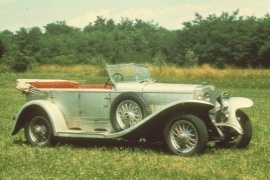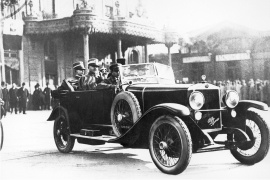ALFA ROMEO RL Models/Series Timeline, Specifications & Photos
First production year: 1922
Engines: Gasoline
Body style: Convertible (spider/spyder, cabrio/cabriolet, drop/open/soft top)
Three years after the introduction of the RL model, Alfa Romeo unveiled the Super Sport version that was produced in 392 units until 1927, when the lineup was withdrawn from the assembly line.
After WWI, many automakers dropped the towels and left the market, but not Alfa Romeo. The Italian automaker survived and resumed production with the RL model, a car that was built in several shapes and sizes. Among them, the Super Sport version came to prove the brand’s commitment to motorsports and continued to thrill its fans and challenge its competitors on race tracks. Among them, the Mille Miglia race held in Italy was the most famous, and the Super Sport’s evolution there wrote a golden page in the marque’s heritage.
Developed to dominate races, the Super Sport version relied on the same chassis as the rest of the range. It featured a front with a V-shaped radiator mounted inside a thick metallic rim that surrounded it. The automaker installed the big, round headlights on a metallic H-structure bolted on the car’s frame. Lower, the semi-elliptic leaf springs were visible and supported the front beam axle.
From its side, the RL Super Sport boasted a wire wheel set, leaving the drum brakes visible. The four-door vehicle featured elegant front arched fenders that continued on the sides with steps and the spare wheel. Since it was difficult and expensive to create rounded glass areas in those times, Alfa Romeo installed a V-shaped windshield with a vertical center slat that divided it. Finally, at the back, the RL Super Sport housed the retractable canvas roof behind the cabin and a vertical panel to end the car.
With a cabin designed for four adults and luxurious leather upholstery, the RL Super Sport became a hit among customers. The floor-mounted gear stick and the neat layout of the dashboard, filled with a speedometer and a tachometer, among a few other dials, were unique to this brand. A four-spoke steering wheel helped the driver keep the car under control even at higher speeds.
But the most important part of the RL Super Sport was under its skin. The sturdy chassis developed for the RL lineup in 1921 featured semi-elliptic springs for both axles. While many other vehicles on the road still featured only brakes for the front ones, Alfa Romeo considered installing drums in all corners, drastically improving the stopping power. It did this because the engine was more powerful than in the regular RL version. While the regular version produced just 56 PS (55 hp), the Super Sport could provide more than 80 PS. Power went to the rear wheels via a floor-mounted four-speed manual gearbox. It also featured a reversing gear.
Soon after World War I, Alfa Romeo resumed production, and the RL lineup was the first model unveiled by the Italian automaker and became famous thanks to its racing results.
Alfa Romeo knew that motorsports was the best way to promote its products. As a result, when it developed the RL, it made it in a few versions so it could win races. The car was introduced in 1922 and was available in the Sport and the Normale grades, with a higher power version for the former. The car was developed by Giuseppe Merosi, the carmaker’s chief engineer. He created a chassis that could handle both engines and an engine that could be improved for races. Usually, in those times, the only thing that a customer could choose from a brand was the vehicle’s body shape. Alfa Romeo delivered the RL as a torpedo, roadster, or rolling chassis to customers wishing to finish the bodywork at specialized coachbuilders, such as Zagato. Alfa Romeo entered four cars in the 1923 Targa Florio race, driven by Ugo Sivocci, Antonio Ascari, Giulio Masetti, and Enzo Ferrari. Each of them represented one of the cloves painted on the car’s bodywork and started the legend of the four cloverleaves legend after the former two sealed the race with a one-two podium finish.
The Italian engineer made the car with a dihedral-shaped radiator and a flat front area. In front of it, on a cross beam, it placed the big and round electric headlights. A pair of thin fenders barely covered the skinny wheels. Merosi didn’t include a front bumper for the vehicle, so the semi-elliptic leaf springs that supported the beam axle were exposed.
From its sides, the RL torpedo featured side steps that emerged from the front fenders and spare wheels attached to the engine compartment. The wire wheels were normal for those times, and both versions of the RL featured them. Surprisingly, for a four-door vehicle, was the split windshield. Merosi couldn’t place a curved glass to lower the drag, so he installed two pieces connected via a vertical slat. The retractable roof could be stored behind the cabin when not in use, and a vertical flat and vertical panel ended the car’s profile.
Depending on the version, the RL was available with up to three rows of seats, allowing six occupants to sit inside the cabin. Customers also could order the vehicle with two rows, so the rear-seated ones could enjoy better legroom and more comfort. The driving position was on the right, and the dials and gauges were placed in the middle of the dash panel.
Despite being developed as a race-capable vehicle, the RL featured drum brakes on the rear axle only. In the Normale version, the car had a longer wheelbase, and its three-liter engine produced just 56 PS (55 hp), while the Sport version provided 71 PS (70 hp). Both shared the same four-speed manual gearbox with a floor-mounted stick.

